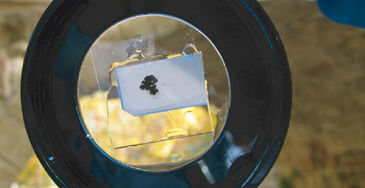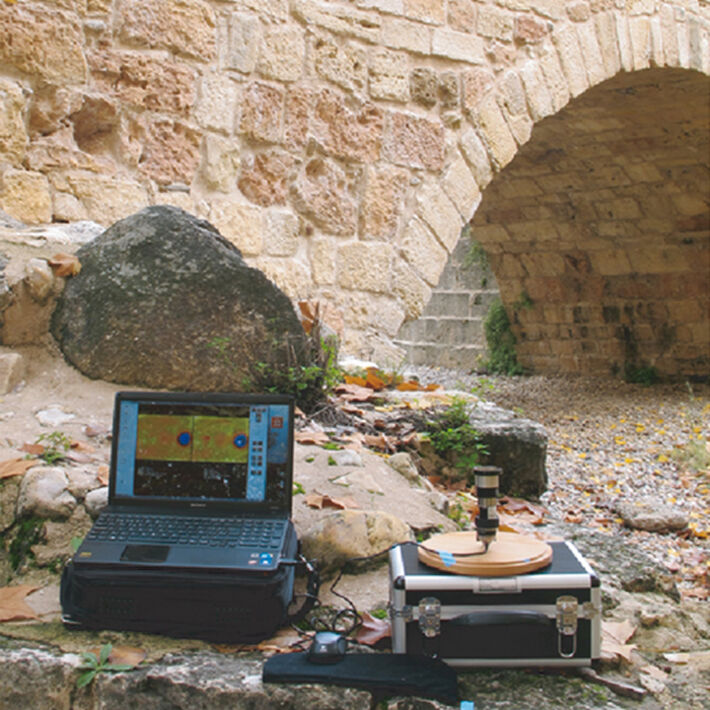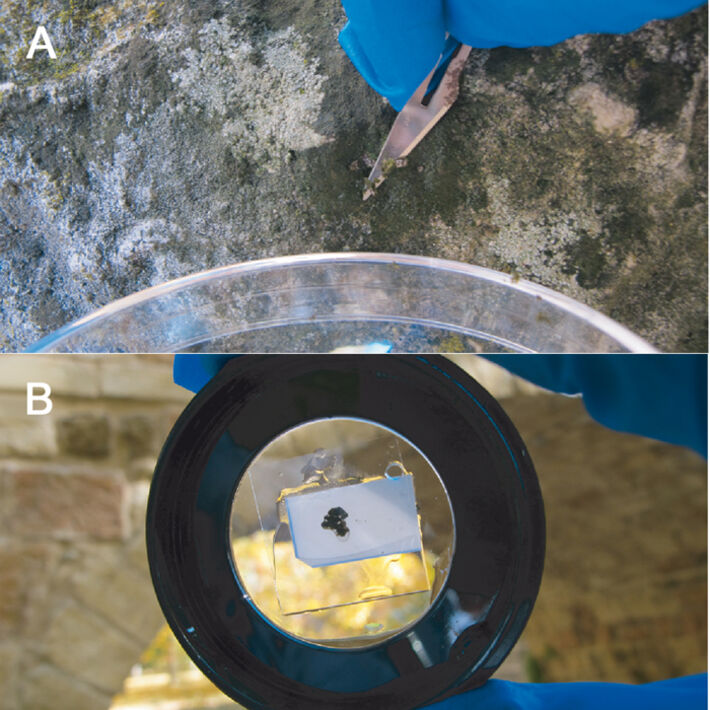Watch tutorials, webinars and informative videos about PreSens optical sensor systems.
Assessing Biocide Actions on Lichen with VisiSens
Controlling microbial biodeterioration on a dolostone Roman bridge
Carmen Ascaso and Jacek Wierzchos
Museo Nacional de Ciencias Naturales - CSIC, Madrid, Spain
Historical monuments are often subject to microbial bio deterioration. Effective treatments that inhibit biological growth on ancient rock surfaces have to be found. In this study biocide treatment on lichen colonizing a dolostone Roman bridge was investigated. The VisiSens oxygen imaging system was used to determine the health or damage of the lichen thallus. It was observed that several days after the biocide treatment the photosynthetic part of this symbiotic organism was damaged and did not produce oxygen anymore.
The Roman Bridge in Talamanca del Jarama (Madrid Province, Spain) is mainly composed of dolostone and features some remains from the Roman period. Most of its ancient rock surface is extensively colonized by lichens. To control the microbial bio deterioration of this monument, treatments that will inhibit biological growth are needed. In turn, the biocide actions of these treatments need to be assessed. However, establishing the efficacy of biocide treatments is laborious and time consuming and requires both long-term field and laboratory studies. Lichens are symbiotic organisms consisting of a fungus (the mycobiont) and a photosynthetically active partner (the photobiont). The photobiont is usually either a green alga or cyanobacterium. In sunlight, the photobiont of a healthy lichen thallus will take up carbon dioxide and water, and release oxygen as the product of photosynthesis. In the dark both symbionts will take up oxygen. When the photobiont is damaged, this will impair photosynthesis and the continued uptake of oxygen by the mycobiont will lower the overall oxygen concentration in the microenvironment of the lichen thallus. By visualizing the amount of oxygen in the thallus its healthy or damaged state can be determined. The VisiSens system was applied in situ for oxygen imaging of treated and untreated lichen and results could be obtained within minutes.
Materials & Methods
A commercial biocide was applied to zones of dolostone showing lichen colonization using a brush. After four days, the zones were moistened with water aerosol, and 10 minutes later, small lichen fragments from control and biocide-treated areas were collected by scraping. Oxygen imaging was performed with the VisiSens system, which consists of an oxygen sensitive sensor foil which is read by a USB powered camera. The oxygen sensor foil (SF-RPSU4, PreSens) had been glued to an optical window with hydrogel and the lichen fragments were placed directly onto the sensing side of the foil. Drops of perfluorodecalin (PFD) were added to the lichen thallus fragments and the sample was covered with a glass cover slip. A black lid was placed on the optical dish to prevent photosynthesis and the sample was immediately placed on top of the VisiSens camera (Detector Unit DU01, PreSens). Images were recorded every 20 seconds for 10 minutes. Several repetitions were performed for the control and biocide-treated lichen thalli. Image recording and evaluation was performed using the VisiSens AnalytiCal 1 software.
Effect of Biocide Treatment on Lichen
Oxygen concentrations in the microenvironment of the healthy and biocide-treated lichen thalli have been visualized in 2D oxygen distribution maps and plots (Fig. 4). The figure shows changes in oxygen concentration after the lichen samples were placed in the dark for 10 minutes. The photobiont of the healthy untreated lichen releases oxygen when kept in sunlight, while the mycobiont consumes some of this oxygen. The symbiotic ecosystem reaches a state of equilibrium with 64 % air saturation in sunlight (Fig. 4, top left). When photosynthesis is inhibited by dark incubation of 10 minutes the "net" oxygen concentration gradually decreases to a constant value of about 22 % air saturation. For the biocide-treated lichen thallus the starting oxygen concentration of only about 9 % air saturation drops to a constant value of about 2 % air saturation within 100 seconds of dark phase. This very low oxygen level indicates no oxygen production by the photobiont and a high consumption of oxygen by the mycobiont cells. This leads to the conclusion, that the photobiont cells of the lichen got damaged by biocide treatment while fungal cells still show signs of metabolic activity 4 days after treatment.
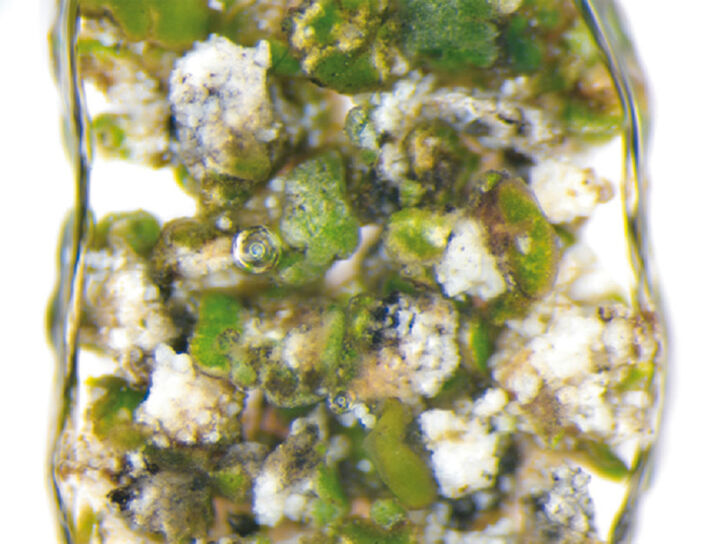
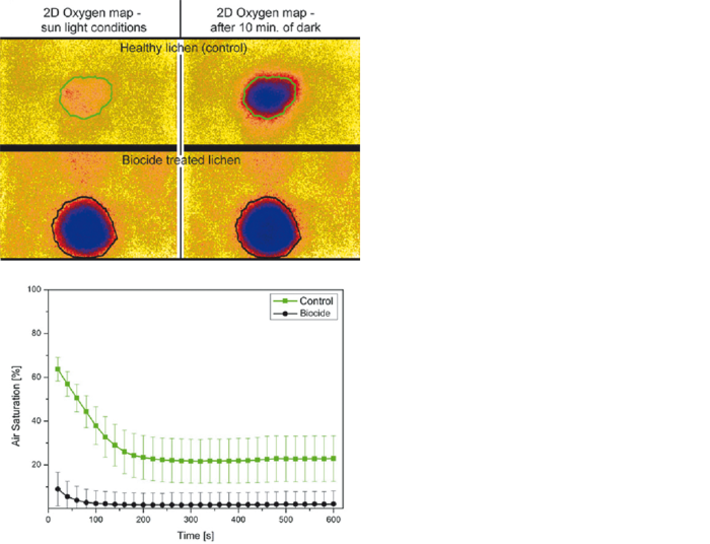
Conclusion
The action of a biocide on lichens colonizing dolostone rock was determined using the VisiSens oxygen imaging system. After four days of biocide treatment, signs of damage to the photobiont cells of the lichen thallus were observed. Such damage will prevent the normal functioning of the symbionts and should eradicate the lichen from the rock. The rapid "in situ" and "in vivo" determination of the efficacy of a biocide offered by the VisiSens system is of great advantage in this field of research. As the system is portable and USB powered, it can be easily taken in the field and set-up right at the research location. This technique also allows for a direct analysis of the health state of a small quantity of biological material on the facade of historical monuments or buildings.

